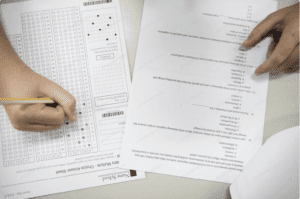You naturally want to get the best marks in your Physics Internal Assessment (IA). When 20% of your final IB Physics grade depends on the IA, a lot is at stake. However, writing an engaging, 24-point-worthy Physics Internal Assessment is a daunting task.
You are not alone in this struggle – thousands of students worldwide have to conduct a physics experiment as part of their IB Diploma Programme. But don’t worry, we are here to lend you a helping hand.
Our team has over 100 years of experience under our belt, with IA Examiners and Physics teachers available at short notice. Note – this article relates to the the syllabus with last examinations in 2024.
Some of the best IB tutors around make TutorsPlus your first contact if you need help or feel overwhelmed.
Below we gathered some handy tips to help you secure top marks in your Physics Internal Assessment.
What is the Physics Internal Assessment?
The Physics Internal Assessment is an assignment, which requires planning and carrying out an investigation or experiment as well as the creation of a report detailing its course and results. What kind of investigation (its topic) and how it is carried out (a computer simulation, hands-on experience, data processing, etc.) is entirely at a student’s discretion. Internal Assessment gives students a more profound idea of physical phenomena and laws, and their real-world manifestations, as well as allows using theoretical knowledge in practice.
Internal Assessment is required for both Higher Level Physics and Standard Level Physics. While Internal Assessment constitutes 20% of the final Physics grade, failing to submit it will put you at risk of not getting a grade for the entire subject.
Choose the Right Topic
Writing an IA on a topic that interests you personally is much more fun than picking any random topic and trying to struggle through it. And this will shine through for the IA Examiner.
When it is clearly seen that you are well invested in your project and are curious about its results, you will be able to check that ‘Personal Engagement’ box. After all, it accounts for 8% of your IA score, and your goal is to get the maximum.
At the same time, you will not get any extra points if your IA directly states that you ‘want to become a marine engineer, that’s why you want to conduct buoyancy experiments’. Instead, your paper must display such things as independent thinking, creativity in your approach, flexibility and adaptivity in solving issues, etc. This is what personal engagement is really about.
Think Through Your Investigation
Before you start your experiment, you need to make a list of all the tools, materials, and equipment you will need. Make sure to consider experiments that you can conduct in your classroom. Otherwise, you may have to rely on less-than-perfect items. This may result in inaccurate and inconsistent results stemming from systematic errors (because your measuring instruments are not properly calibrated, for example).
Next, you need to come up with research questions relevant to the topic. Don’t make them too broad. For instance, ‘How does the rate of vaporisation change based on the surface area?’ is a much better option than ‘Investigation into the rate of vaporisation of water’.
At the same stage, you need to decide what your variables are (both independent and dependent ones) and how you are going to measure them. Ideally, you should define your variables to make sure you know what you actually measure.
Along with that, you need to write your methodology (in sufficient detail but not too overwhelming) so that a reader is able to replicate your experiment. Also, ensure to elaborate on the factors that may affect your experiment.
If you succeed in planning your future experiment, you can secure all 6 points for the Exploration criterion.
Conduct Your Experiment
Once you know what you want to experiment with and you have everything you need at hand, it’s time to get cracking!
You need to gather enough raw data to consider your experiment done properly. That’s why it is recommended that you repeat your investigation at least three times (with smaller investigations you should consider five repetitions or more). With every repetition, use the same method, equipment, and setup.
Ideally, the results of all the repetitions must be more or less equal. If you notice considerable discrepancies, you should analyze why they occurred and, if possible, eliminate them as well as suggest improvements for further experiments.
To keep all the data well-organized, it’s best to use Excel, Logger Pro, or other software. Putting the raw data in a table allows presenting your measurements in an easy-to-digest form. It will also come in handy when you process your data.
Introduce Graphs
The best way to show the relationship between two (or multiple) variables is a linear graphic. In case this relationship is not linear, you need to linearize it using a constant factor. After a graph is done, the next step is to analyze if the calculated relationship holds up to that of the theoretical.
When creating graphs, you should keep the following in mind:
- A graph ought to take at least half of the page and be labelled;
- A graph must demonstrate the correct units;
- A graph must correlate to the raw data presented in a table;
- A scale must be reasonable (for example, divisible by 10, not 7).
The experimental part of your Internal Assessment, along with the visual demonstration of the result, contributes to the Analyses criterion. It is important to note it constitutes 25% of the total score.
Evaluate Results
In this part of your Physics Internal assessment, you reflect on the results of your experiment and draw a conclusion.
Here, you need to look closely at your calculations and compare them with physical values. If there are discrepancies, it is vital to identify where they came from.
The most common sources of mistakes are your equipment (for example, digital meters round the values), human factors (such as reaction time), procedural methods (for example, if you round up your numbers in one instance and round them down in the another), environmental factors (for example, changes in temperature or pressure), or random errors.
Whatever the cause of discrepancies is, you need to address it, deal with it if possible, and explain its effect on the results of your investigation. Please keep in mind that examiners don’t expect scientific-grade work from students. Instead, they expect students to understand why their results turned out one way or another and what they could do differently to reduce errors and uncertainties.
Evaluation is as important as analyses (both are responsible for 25% of your total score).
Use an Appealing Structure and Formats
Even if you’re a brilliant experimenter, a poorly written report won’t get you anywhere. That’s why you should present it in the best light possible. The key signs of a well-written report are:
- Clear and concise language. Your report should be study-specify but not too overwhelming. Don’t make it too vague or generic.
- An appropriate and relevant use of terminology, labelling, units, equations, etc.
- Consistency of calculations, units, decimal places, etc.
- A reasonable structure (i.e. separate sections with headers), well-presented visuals, well-organized tables, etc.
A report should have 6-12 pages. You can make it longer if you have a good justification. Overall, it should consist of the following parts:
- Introduction – provide a short background on your investigation, why it is important to you and what you want to achieve.
- Theoretical background.
- Setup (what kind of equipment, tools, and materials you use and how).
- The results of the investigation with a table of measurements.
- Analyses including calculations and graphs.
- Error and discrepancy analyses.
- A conclusion that details the results of your investigation and highlights your errors and their effect on your calculations. In the same section, you can suggest ways to improve your experiment.
The communication criterion is worth 17% of the total score. That’s why it is important that your report ‘communicates’ with readers in the right language.
and finally….
The importance of IA cannot be underestimated. It is virtually impossible to get a 7 in your IB Physics course if you submit a mediocre paper riddling with errors and missed opportunities.
Are you stuck, limited in time, or simply don’t know where to start? Let TutorsPlus be the shoulder you can lean on. We are an experienced team of IB tutors and examiners, and we know how top-rated Physics IAs should look like.
Our goal is to help you make the most of your abilities to maximize your IB Physics score. With your dedication and our expertise, you can move mountains. So don’t hesitate to get in touch – TutorsPlus are available at 022 731 8148 and info@tutorsplus.com.











